
25 minute read
NDITSHENI MANAGA
We Will Rise Again NWU Gallery 11 March - 9 April
Curated by Amohelang Mohajane
Advertisement
Opposite Page: Marketplace
The past year has been an unmatched one, triggering our survival instincts. We have all been affected by Covid-19 differently over the past year. Over the months we have adjusted our lifestyles to survive.
The informal sector is about survival, hustling and strategizing to make ends meet. Informal traders are at most not seen, invisible but play a huge role when we need something spontaneously.
The people behind these small businesses are strong willed, patient and show great perseverance. What are their stories? What are their dreams? What is the vision? What is their anchor?
As I travel the streets of Johannesburg they have become part of my consciousness of needing to understand their stories. I am curious about how Covid19 has affected their livelihood. The different levels of lockdown affected how they could trade, customers were no longer buying at the same usual rates. This also made it competitive as traders fought to be noticed, another impact was the stock. In the case of food, did they have to get rid of rotten stock, how did they comprehend this whilst trying to survive?
However I see their strength as well. The virus has also taught us appreciation, as the different levels of lockdown open and close. We are able to see the local bicycle ice cream man return to his business and put a smile on the kids’ faces again. Families are able to access affordable food for their households.
Informal traders teach us many lessons about this life, they are a metaphor for what we are faced with globally and if we can take one thing from them today, is that we will overcome this challenge, that we stronger than we believe we are, that we play an important role in this life and we will rise again.


Eatery. Opposite Page: Bree Street Bananas


THE ENDANGERED WILDLIFE TRUST CONTEMPORARY 21
Gordon Institute of Business Science, Johannesburg 4 September - 12 September 2021
In 1973, Clive Walker, passionate about the conservation of South Africa’s Cheetah, decided to use his talent as an artist to raise awareness and much-needed funds for a study on the species’ conservation status under the Eugene Marais Chair of Wildlife Management at the University of Pretoria. On 20 June 1973, he put out a Cheetah Appeal in wildlife magazines and newspapers, advertising the exhibition and sale of 240 limited edition, numbered and signed prints of a painting he did of a Cheetah (pictured here). The exhibition was a sellout at R20.00 a print.
After the exhibition’s success, Clive continued his quest to raise awareness of the plight of threatened wildlife species by joining up with James Clarke and Neville Anderson to establish the Endangered Wildlife Trust later that same year and remaining at its helm for thirteen years.
Borne at the hands of an artist, the EWT has always used powerful imagery to evoke the emotional connection and sense of wonder many people feel towards wildlife and to tell these animals’ stories. Art and photography are profoundly powerful means of communication and are useful as both teaching and learning tools - visualisation a more in-depth, and often more honest, form of expression.
While our work is informed by robust science, some things are better understood visually, and some have to be seen to be believed. We can wax lyrical about a pangolin, describe its scaled body, tapered at both head and tail, its long tongue, and the unusual way it walks on two legs, but there are nuances to living beings that one can only feel and fully understand by using our senses of sight and sound, and smell if we can get close enough. These are, after all, the fundamental tools of scientific investigation and discovery.
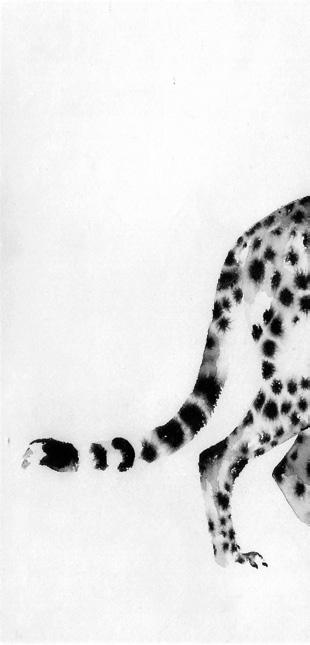


Clive Walker destroying the original printer plate to show that the prints sold were indeed limited editions. (Image credit: Clive Walker).
One of the first things we do in conservation awareness and education programmes is to ask learners to draw an animal. This activity helps them understand the animal’s structure and what habits and behaviours its particular physical attributes afford it. It also gives us an indication of how the learners interpret their conceptualisation of an animal. Do they know enough about it to depict it accurately, or are there perhaps elements of cultural perceptions or stereotypes present in the drawings? How do they feel about the animal – are they afraid of it? Armed with this knowledge, we are better equipped to provide compelling educational experiences that deepen our understanding of wildlife and what needs to be done to ensure its survival.
Almost 50 years after Clive Walker took up his paintbrush for conservation, the EWT has grown into one of South Africa’s largest and most respected regional conservation non-governmental organisations, with an expanding footprint throughout southern and East Africa. This year, we are going back to our roots to celebrate what the visual arts have contributed to the conservation of our wildlife and the breathtaking ecosystems they call home. We invite local artists to submit works that speak to the EWT’s vision of a healthy planet and an equitable world that values and sustains the diversity of all life for an exhibition entitled The EWT Contemporary 21. The exhibition will be held at the Gordon Institute of Business Science (GIBS) in Illovo, Johannesburg, from Saturday 4 September–Sunday 12 September 2021. We hope you will join us to celebrate our natural heritage and look towards a brighter future, protecting forever, together.
Auction News STEPHAN WELZ & CO.
www.swelco.co.za
The art world has seen many changes in recent months, with buying pools shifting and markets changing direction and focus. While it would be easy to attribute these changes to the effects of Covid-19, many dynamic factors power the art sector, and changes within one area influence those that move around it. The art specialists at Stephan Welz & Co. have been witness to an extremely exciting time in the art realm, as buyers are becoming more receptive to new ways of consuming and purchasing art, leaving room for innovative approaches to art auctioneering.
Following our recent Cape Town February auction (which saw some extremely pleasing results in terms of our contemporary collection), recent changes in the focus of the art market are beginning to become more apparent. Over our last few sales, we have seen an unprecedented amount of interest in works by the likes of William Kentridge, Penny Siopis, Marlene Dumas, Diane Victor and Deborah Bell.

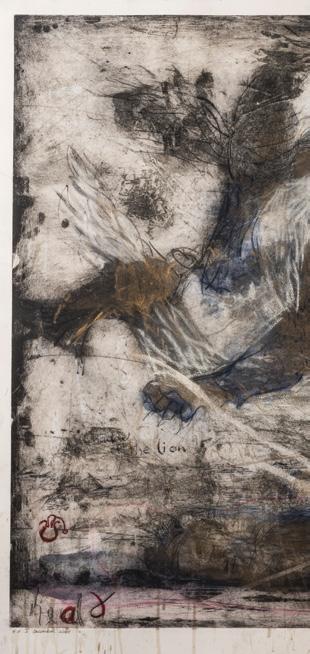

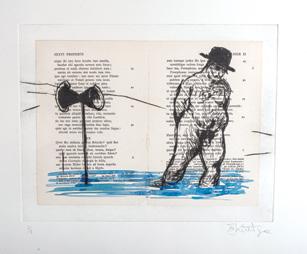
William Joseph Kentridge, Sexti Properti, Sold for: R60 000
These living artists, beginning to be seen as ‘Contemporary Masters’, are at the forefront of both the South African and international art market. While there will always be a core pantheon of South African artists, made up of the likes of Irma Stern, Alexis Preller and J.H Pierneef, contemporary masters of the South African art scene are building on the foundation of these already-acclaimed artists, to present works that represent a more modern South African context.
Our art team has seen a steady shift in the sales of more traditional works, such as classic landscapes, as these pieces— often inherited from older generations— have seen a decline in popularity. Not only does this suggest a refinement of the current market, but it also reflects the way in which contemporary art is moving up the ladder within the context of the auction world. We have seen an exciting overlap between primary gallery spaces and the more traditional auction environment, as younger, emerging contemporary artists are being featured on auction more frequently. In this way, a variety of contemporary pieces are being exposed to more people than just gallery-goers, widening audiences and in turn, buyer pools. These buying pools are also seemingly dominated by younger buyers that are either looking for a range of art investment opportunities, or are passionate art collectors. A younger buying market may also be as a result of ever-changing art spaces and how we handle art in the age of Covid-19. While the characteristically traditional auction world has previously been hesitant to adopt technology into auction practices, many auction houses have now made the move to online platforms and adopted a hybrid approach to selling works. This makes the larger art market more accessible to the average person, and can be accessed easily, without needing to dedicate hours of time to visit a gallery or auction, as buying art could potentially be a process of only a few clicks.
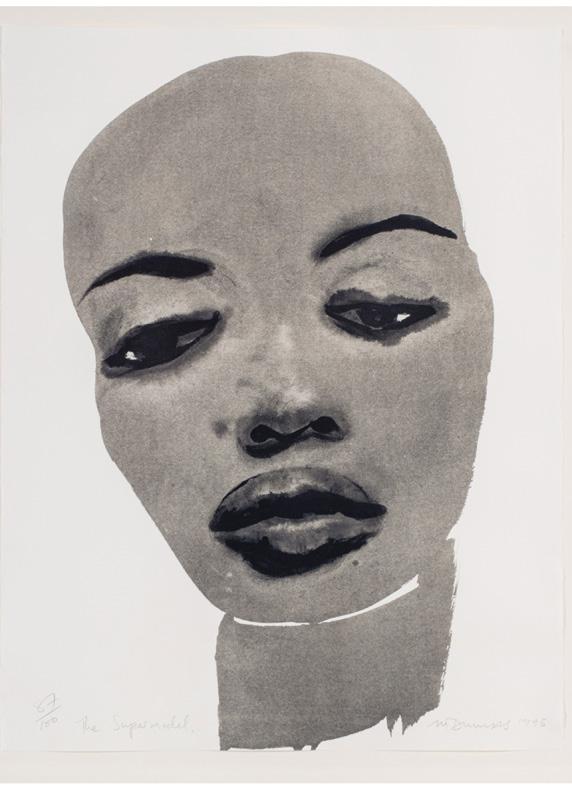

Irma Stern, Melon Seller At A Zanzibar Market, Sold for: R950 000
In combination with an increase in contemporary interest, it is extremely encouraging to see an increase in acknowledgement for certain historical artists who were previously overlooked. Artists such as John Muafangejo, Esther Mahlangu and Helen Sebidi were always seen as important in the history of South African art, but have recently seen a surge in secondary market value, becoming highly collectable within a more contemporary context. This also translates to a broader increase in international interest in South African art, which can be seen by the presence of dedicated sales at Bonhams and Sotheby’s. In this way, we are no longer only dealing with local tastes and interests, but also international demands, which can in turn affect local markets. It seems apparent that the new way of conducting art business is more in tune with contemporary artists and buyers. Stephan Welz & Co. is pleased to be part of a new wave of art, making its way into the auction realm, and we stay dedicated to making the procurement of art, consignment and buying as effortless as possible for our clients and collectors. We are so looking forward to what the next chapter of art at Stephan Welz & Co. will look like.
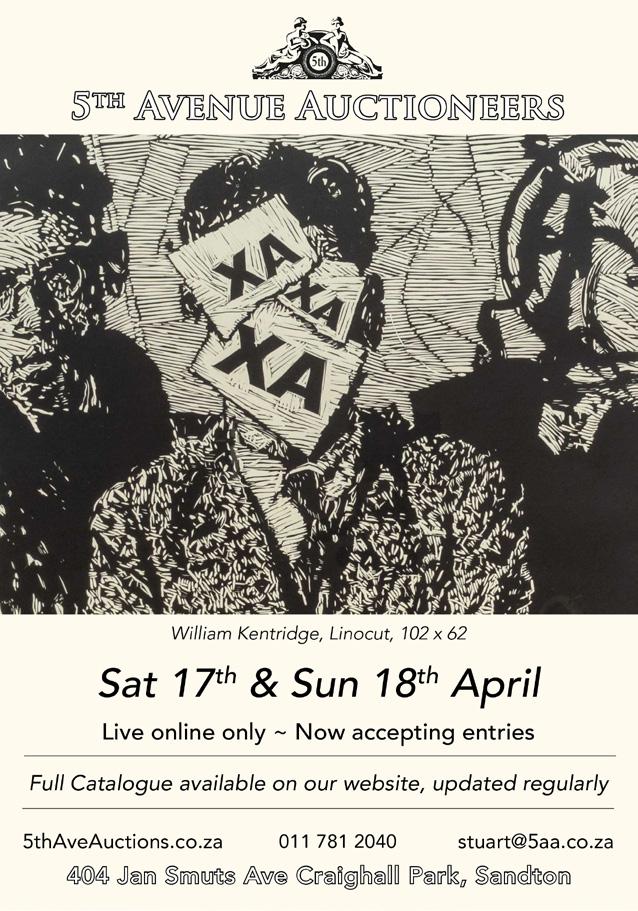
Auction News STRAUSS & CO
KWV Collection and five-star Pierneefs lead Strauss & Co’s April marquee sale
Strauss & Co is pleased to announce details of its forthcoming live sale of modern, post-war and contemporary art, decorative arts, jewellery and fine wine, due to be held over three days from 11 to 13 April. This sale, the company’s first marquee live event for 2021, includes an important historical collection of art assembled over half a century by the Cape Wine Growers Association (KWV), two important collections of Chinese porcelain and a producer-themed sale of wines from three legendary Cape estates. A transcendent JH Pierneef landscape dominated by baobab trees leads a top-quality selection by this master landscape painter.
“Our four marquee live sales are important calendar events for collectors, as this is when Strauss & Co reveals its premium offerings and presents its single-owner properties,” says Strauss & Co joint managing director Bina Genovese. “The catalogue for the April sale is no exception. The painting selection is bracketed by two important historical landscapes by Thomas Bowler and a selection of graphics by contemporary masters of the form, Mr Brainwash and Banksy. The live sale will integrate various bidding options, from commission to telephone, online and in-person bidding, to ensure effortless transacting and personal well-being.”
Started in 1958, the KWV Collection features post-war paintings rooted in the Cape region, its landscapes, people and industries. Formerly displayed at the Laborie Manor and KWV Sensorium in the La Concorde head office, both in Paarl, the consignment to Strauss & Co includes The Origin of Wine/The Epic of Gilgamesh (estimate R800 000 – 1.2 million), an elaborate panel piece commissioned by KWV from Cecil Skotnes. The work narrates the history of wine and its arrival in South Africa and marked a pivotal moment in the artist’s later career. The collection also includes two Skotnes table settings, notably Still life with Bottles (estimate R400 000 – 600 000) and Wyn wat die Meuse-hart Verheug (estimate R60 000 – 80 000)
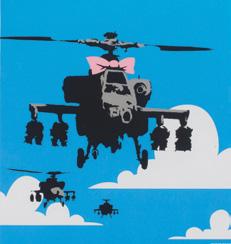
Other highlights from the KWV Collection are Erik Laubscher’s late landscape Winter Vines, Kloovenberg (estimate R400 000 – 600 000) and Maggie Laubser’s Still Life with Dahlias and Grapes (estimate R250 000 – 350 000). Collectors of Cape landscapes are directed to works by Marjorie Wallace and Gregoire Boonzaier, in particular the latter painter’s Edge of the Forest, Kenilworth (estimate R150 000 – 2000 000) and After the Rain, Kenilworth (estimate R 250 000 – 350 000). The KWV Collection also includes figure studies and portraits by François Krige, Christo Coetzee and Maurice van Essche.
Left: (Detail) Banksy, Happy Choppers, 2003, colour screenprint image size: 67 by 48cm, R 900 000 - 1 200 000. Oppsite Page: Mr Brainwash, Madonna, silkscreen and spraypaint on canvas 120,5 by 120,5cm.


Thomas Bowler, Port Elizabeth circa 1861, oil on canvas laid down on board 40 by 63cm, R 150 000 - 200 000
Oil paintings by Thomas Bowler are exceedingly rare with only twelve examples known to be in existence. Strauss & Co is delighted to offer two Bowler oils consigned by Metropolitan Life: the undated maritime scene Arrival of the East Indiaman, St. Lawrence in Table Bay, Cape of Good Hope (estimate R100 000 – 150 000) and a bay scene of Port Elizabeth made circa 1861 (estimate R150 000 – 200 000). Both works have excellent provenance and exhibition histories.
Two works by JH Pierneef from the property of a gentleman lead an impressive selection of works by this auction bellwether in the April sale. Painted in 1952 and measuring 44,5 by 59cm, Baobabs (estimate R2.5 – 3 million) is a fine example of Pierneef’s ornamental late style of depicting the northern landscapes of South Africa. Consigned by the same seller, a 1906 still life executed in charcoal and pencil (estimate R250 000 – 350 000) reveals Pierneef’s solid grounding in the academic tradition. Other notable Pierneef lots in the April catalogue include his epic of tone and mood, Sunlit Mountains, Clarens (estimate R1.5 – 2 million), and Elephant Castle, Selati Rivier, Phalaborwa (estimate R1.8 – 2.4 million), an assured work from 1945 depicting the confluence of the Selati and Olifants rivers outside Phalaborwa. Findlay Farm, Magaliesberg (estimate R1.2 – 1.6 million) portrays the region surrounding Hartbeesport Dam and was made shortly after Pierneef’s divorce from his first wife, Agatha, in 1924. A tireless traveller of his homeland, Fishing Boats, Hout Bay (estimate R2 – 3 million) dates from 1942 and depicts a pair of sculptural fishing boats backed by a row of coastal houses and mountains.
A notable highlight of the sale is Maggie Laubser’s Shepherd and Sheep (estimate 1 200 000 – 1 500 000). Executed in 1924 when Laubser returned from Europe to her family farm, it represents one of numerous paintings of Ou Booi, the bushman who was the shepherd on the farm sporting his trademark outfit.

Jacob Hendrik Pierneef, Stillewe, charcoal and pencil on paper 43,5 by 57,5cm, R 250 000 - 350 000, Property of a Gentleman
The middle of the twentieth century was a time of change and innovation for South African painting. Three painters stand out. Alexis Preller’s Constellation from 1966 (estimate R650 000 – 850 000) is a low relief made of gesso, oil and gold leaf on wood and features abundant galactic allusions. Christo Coetzee’s After Japan (estimate R250 000 – 350 000) recalls his important work visit to Japan in 1959-60, and was first exhibited at Galerie Stadler, Paris, in 1961. Erik Laubscher’s vividly coloured trio of acrylics – Eggs and Gasket, Still Life: Homage to Marsden Hartley, recto; Buildings, verso, and Abstract Still Life (estimate R250 000 – 350 000 each) –derive from his confident middle period in the 1970s.
The vibrant Laubschers are the property of a private collector. Another notable lot from this collection is American painter Larry Rivers’s notational portrait of his lover titled Head of Molly (estimate R200 000 – 300 000). The work was acquired from dealer Joe Wolpe and has been authenticated by the Estate of Larry Rivers. The story of painting is one of many possibilities Adriaan Boshoff’s impressionist studies of farm life and youth have been a staple of private collections since the 1970s and over the past two decades he has commanded solid prices at auction. Boshoff’s Cattle Branding (estimate R900 000 – R1.2 million) leads a selection of four works by this self-taught painter.
Contemporary painters represented in the sale include Arlene Amaler-Raviv, Beezy Bailey, Jan-Henri Booyens, Tom Cullberg, Matthew Hindley, Ayanda Mabulu, Joel Mpah Dooh, Thierry Oussou, Lionel Smit and Pierre Vermeulen. Esther Mahlangu’s 2014 canvas Abstract (estimate R70 000 – 100 000) records her commitment to a culturally resonant hard-edged abstraction. Mustafa Maluka’s two canvases, They have got to Hate what they Fear from 2008 (estimate R200 000 – 300 000) and You Say you Know how we Feel from 2007 (estimate R200 000 – 250 000), are large, colourful, bold portraits of street smarts.
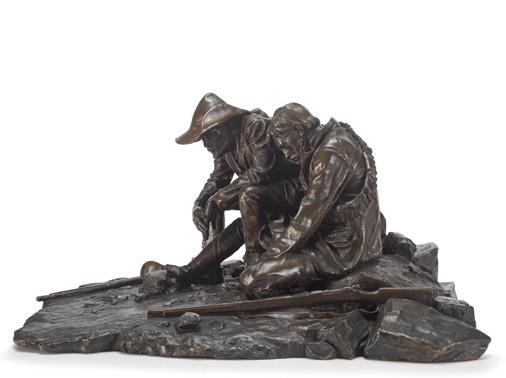
Anton van Wouw, Slegte Nuus, bronze on a wooden base, height: 33cm, excluding base; 37cm, including base, R 2 000 000 - 3 000 000
The sculpture offering also spans generations. Anton van Wouw’s Slegte Nuus (Bad news, estimate R2 – 3 million) was conceived in 1907, during a hot streak of creativity, and movingly portrays two crestfallen Boer soldiers. Dylan Lewis is best known for his large cat bronzes. Resting Cheetah III S224 (estimate R900 000 – 1.2 million) dates from 2004 and is from a small edition of only 12 bronzes.
Following on a successful run of themed fine wine sales, Strauss & Co’s wine department will present a producer-focused sale devoted to De Toren Private Cellar, Meerlust Estate and Mullineux Family Wines. Tracing its history back to 1991, De Toren is undergoing a transformation under Swiss-based CEO Daniel Mueller. The De Toren list for the April sale focuses on the winemaker’s celebrated Bordeaux blends: the maiden vintage of their Fusion V (1999), the ultra-luxurious and widely feted Book XVII (2012), handcrafted, limited-run Fusion V Directors Reserve (2009). The decorative arts department will be presenting historical Cape and contemporary international furniture, fine jewellery, silver and two exceptional collections of Chinese porcelain. Strauss & Co’s offering of historical Chinese porcelain, jade and objets d’art have consistently exceeded pre-sale estimates in recent live sales.
Strauss & Co’s marquee live sale will commence on Sunday, 11 April with a session devoted to the three Cape wine producers and it will conclude on Tuesday, 13 April. The sale will be livestreamed to bidders from two sales venues in Cape Town and Johannesburg. There is an option of inperson bidding at both venues. Covid-19 safety protocols apply throughout.
Auction Preview: 6-11 April 2021Brickfield Canvas, 35 Brickfield Road, Woodstock, Cape Town

ENIGMAS OF ARRIVAL JOHN MEYER
Ashraf Jamal
Driving towards Rosebank from OR Tambo airport, I see a monumental declaration running down the flank of a tall skinny building: JESUS = LOVE. I send the pic to a friend who promptly replies: ‘Now you know’. I’ve never been OK with equivalences. This one is dressed up as mathematics, except its metaphorical, and, as Nietzsche reminded us, a metaphor is nothing but the equating of the unequal. Not wishing to be churlish, I’m prepared to give a believer the benefit of the doubt. For me, Jesus is more explicable than love can ever be. Whether they are one and the same thing is questionable, because love is that mysterious portmanteau in which one size fits all – all faiths, desires, hopes, and longings.
This preamble – JESUS = LOVE – returns to me on entering the Circa Gallery in Rosebank, Johannesburg, in which a suite of sixteen paintings of the life of Nelson Mandela were on show. Painted by John Meyer, they range from Mandela’s childhood to his last moments on earth. If the series reads like a biopic, the artist distilling heightened moments in the great leader’s life, it is because Meyer is greatly inspired by cinema. Distillation is key, because as Meyer tells me, the paintings are not records of documentary footage, but re-imaginings of moments which many South Africans collectively recall – Mandela defiant at the Rivonia Trial, incarcerated on Robben Island, for example. However, it is not a historical record which Meyer gifts us, but, more loosely, more capaciously, visions of Mandela, spanning decades, which, moment by cinematic moment, conjure what might have occurred, how that scene might have shaped him. Because, of course, lives are never merely predestined, they are created. A great life is one in which key moments, when bound together to form a rosary, can, in their coupling, produce a divine or profound congress.
One could say that MANDELA = LOVE. For if there is one distinctive marker in Meyer’s paintings, it is his ability to convey the bounteous and steadfast grace of the greatest leader of the last hundred years. There is nothing deferential, or reverential, about Meyer’s record. Instead, what Meyer captures is the sublimity built into ordinary and dramatic moments. If Pantheism supposes that there is a God in all things, then, I imagine, it is this more inclusive divinity which Meyer captures. If MANDELA = LOVE, it is because of the many faces which love conjures.
The opening painting is of three young black boys racing along a dust country path led on by a dog, all about we see rolling fields and hills, a great bright sky. The closing painting is of Mandela, cane in hand, his back towards us, walking along that same path. Now the sun is setting. As bookends, these paintings sum up the arc of a life from birth to death. But what distinguishes Meyer’s take, be it of youth or age, is its painterly exuberance, its elan vital. In the opening painting it is clear that vitality is the key. That no photographic record exists of this moment, means that it had to be invented – which is Meyer’s central point. His paintings are not objective records but fabulations, or ways of dreaming. What interests the painter most of all is that Nelson Mandela is as mortal as he is saintly, as ordinary as he is stately. Given our terrible tendency of turning celebrity into myth, men into gods – the result of our increasing divorce from reality, our enslavement to the virtual – it is
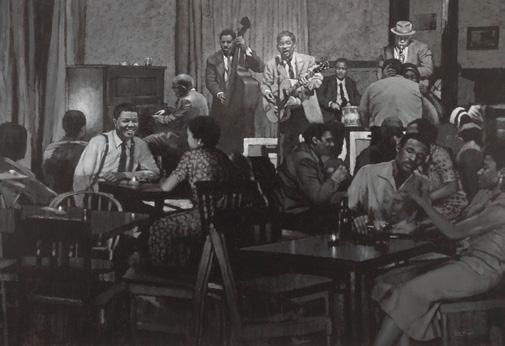
Jazz Club

unsurprising that Mandela, today, is more a godhead than a man. But, as Meyer reminds us, to subtract and abstract a human being thus is to lose sight of the mortality that allows for grace.
Grace is the one word which Meyer returns to when he reflects on his personal encounter with the great statesman. That he was personally chosen to paint Mandela’s portrait is, in itself, a towering achievement. For Meyer, however, it was never merely a matter of honour, or a ground-breaking career moment, but, most profoundly, a way to express what pervades all his paintings – emotion. While he is hailed as a great South African Realist – I see him as an Impressionist – what, for Meyer, matters most in the act of painting is an emotional trigger – the moment in which he and his subject connect, what unfolds in that moment of connection. In the case of Mandela, it was the great man’s boundless patience and generosity.
In the central painting we see Mandela standing erect, his hand clutches the back of a chair, the other softly unfolded, the gaze direct. In many ways this painting is classic portraiture, in the manner, say, of Anthony van Dyck’s painting of King Charles I. But what makes Meyer’s take striking is the fact that he is never preoccupied with meticulously recorded detail. On closer inspection you see the looseness of the brushstroke, as though the painter, moving back and forth, sought an aggregation far more than any defining detail. It is the looseness and lightness of the brushwork, suggesting a speed in the making, which further helps us to understand how Meyer arrives at a dramatic and emotional moment. Because his painting are never declarations, but, rather, suggestively choreographed, it is as if one were entering a scene in mid-flow, as if one were meant to piece together what had happened and what is to follow. It is in this way that his painting read as cinematic stills.
In the case of his series of paintings of Mandela, what we get is a broken narrative, certain fragments in a life which we are compelled to suture. This is because it is the viewer who must complete the story – the great mystery of a great figure. Before speaking with Meyer, I assumed the challenge of painting a great public figure would be daunting. After all, how does one paint someone as mythic yet real and profoundly honest as Mandela? Where is the painter in the project? How does one reconcile the iconic power of Mandela with Meyer’s particular way of painting? For if Meyer’s eye can be said to be cinematic, one cannot ignore that that very eye is also obtuse and fungible. Given that Meyer is inspired by photographs – which abduct and skew the truth, despite the fact that we view them differently – it seems that photographic records, for Meyer, are no different to invented memory, in so far as both are merely foils for an inner painterly vision.
If Meyer’s way of combining technique and invention is important, it is because it profoundly informs the way he sees Mandela, whether in person, or via a photographic image. For Meyer, I imagine, it’s the mystique and enigma of the man that matters most. Looking at his suite of paintings – each an evocative moment – I’m guessing that he knew that we, the viewers, would have to complete the story, that the role of his paintings in our lives – in the life of the nation, and the world – would be to profoundly add to the narrative in our heads and heart. In a nightclub scene, jazz musicians in the background, we see Mandela in avidly intimate conversation with

Black Pimpernel

A crucial decision
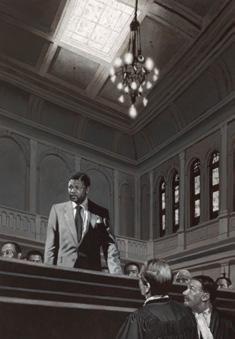
Prepared to die President Mandela
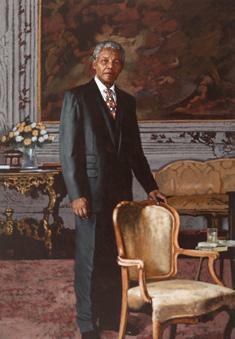
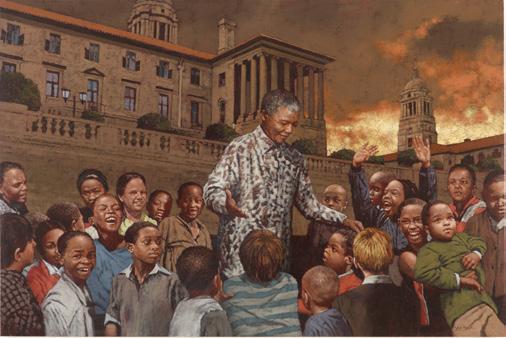
Father of the innocents
a woman. The tagline might be ‘Mandela the lover’, or ‘Mandela the romantic’. The taglines for other paintings might read, ‘Mandela the firebrand’, Mandela the bruiser’. The scenes vary from pastoral to urban, longshots to medium shots with Mandela as a remote speck in the gloaming distance or prominently showcased in a heated or gentle debate. The variety is deliberate, because no man is ever one thing. The man, the symbol, is never quite the same being. Add to this mystery, the mystery of painting itself, and we arrive at a very fertile compound.
If what we get in a Meyer painting is both the elemental and the ordinary, it is because the painter drifts between worlds. Therefore, to interpret this series of paintings solely as works devoted to the life of Mandela is to miss a key point – that technique is a vital ingredient in any illumination. In Meyer’s case, paint quivers, darts, the whole is as evocative, as plausibly real, as it is schematic. Is Meyer perhaps a roughshod Pointillist, someone who stubs and dabs meaning into the world? Is the perceptible blur he conjures a lesson in obfuscation? Here, the title of a painting by Giorgio De Chirico comes to mind – ‘enigma of arrival’. To my mind, Meyer’s cycle of paintings on the life of Mandela amounts to a quest – they are enigmas of arrival. If this is so, it is because they were never a record of definitive moments but intuitions thereof, and, therefore, never intended to be exemplary. I say this because I believe that Meyer never intended to create myth, despite knowing that this graft would prove inevitable.
In conclusion, I return to the hoarding which reads: JESUS = LOVE. I doubt that John Meyer would agree. This is because what inspires him is never an equivalence. His paintings of Mandela are a record of this disagreement. Therein the known encounters mystery, legend rubs against fallibility, grace its passing and its eternality. In that final painting we see an old man drift away into the descending sun, and know that never, not in this lifetime or the next, will such a man ever be forgotten.



